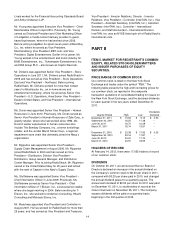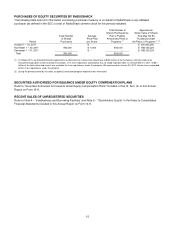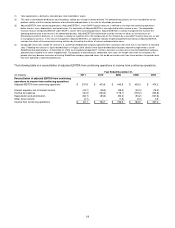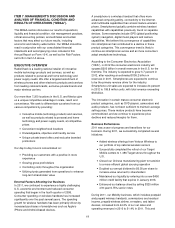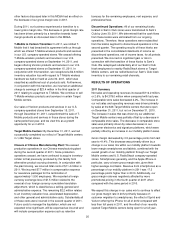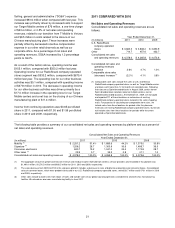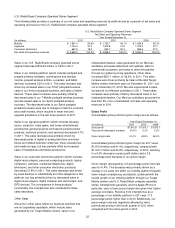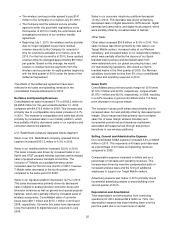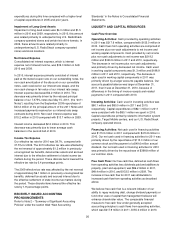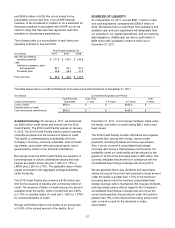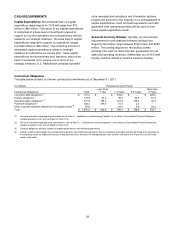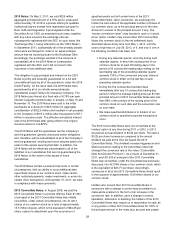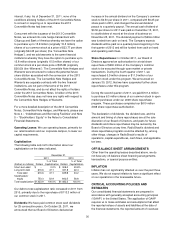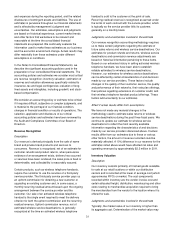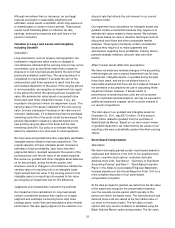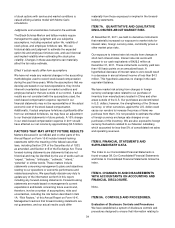Radio Shack 2011 Annual Report Download - page 32
Download and view the complete annual report
Please find page 32 of the 2011 Radio Shack annual report below. You can navigate through the pages in the report by either clicking on the pages listed below, or by using the keyword search tool below to find specific information within the annual report.
24
Depreciation and Amortization
The table below provides a summary of our total
depreciation and amortization by segment.
Year Ended December 31,
(In millions) 2011 2010
2009
U.S. RadioShack
company-operated stores
$ 37.9
$ 45.4
$ 45.8
Other 8.7 5.2 6.4
Unallocated 36.1 32.8 38.1
Total depreciation and
amortization from continuing
operations
$ 82.7
$ 83.4
$ 90.3
The table below provides an analysis of total depreciation
and amortization.
Year Ended December 31,
(In millions) 2011 2010
2009
Depreciation and
amortization expense
$ 75.2
$ 75.7
$ 81.1
Depreciation and
amortization included
in cost of products sold
7.5
7.7
9.2
Total depreciation and
amortization from continuing
operations
$ 82.7
$ 83.4
$ 90.3
Impairment of Long-Lived Assets
Impairment of long-lived assets was $3.1 million and $4.0
million in 2011 and 2010, respectively. In 2011, these
amounts were related primarily to underperforming U.S.
RadioShack company-operated stores. In 2010, this
amount was related primarily to underperforming U.S.
RadioShack company-operated stores and certain test
store formats.
Net Interest Expense
Consolidated net interest expense, which is interest
expense net of interest income, was $43.7 million in 2011,
compared with $39.3 million in 2010.
In 2011 and 2010, interest expense primarily consisted of
interest paid at the stated coupon rate on our outstanding
notes, the non-cash amortization of the discounts on our
long-term debt, cash received on our interest rate swaps,
and the non-cash change in fair value of our interest rate
swaps. Interest expense increased $4.9 million in 2011.
This increase was driven by the increased average amount
of long-term debt outstanding during 2011, the increased
debt discount amortization related to our 2.50% convertible
senior notes due August 1, 2013 (the “2013 Convertible
Notes”), and increased commitment fees related to the five-
year $450 million asset-based revolving credit facility we
entered into on January 4, 2011, with a group of lenders
with Bank of America, N.A., as administrative and collateral
agent (the “2016 Credit Facility”). Non-cash interest
expense was $17.0 million in 2011 compared with $15.2
million in 2010.
Income Tax Expense
Our effective tax rate for 2011 was 37.5%, compared with
38.7% for 2010. The 2011 effective tax rate was affected by
the realization of job retention credits generated pursuant to
the Hiring Incentives to Restore Employment Act. These
credits lowered the effective tax rate by 1.1 percentage
points.
The 2010 effective tax rate was affected by the net reversal
of approximately $1.2 million in previously unrecognized tax
benefits, deferred tax assets and accrued interest due to
the effective settlement of state income tax matters during
the period. These discrete items lowered the effective tax
rate by 0.4 percentage points.
2010 COMPARED WITH 2009
Wireless Service Provider Settlement Agreement
The business terms of our relationships with our wireless
service providers are governed by our wireless reseller
agreements. These contracts are complex and include
provisions determining our upfront commission revenue,
net of chargebacks for wireless service deactivations; our
acquisition and return of wireless handsets; and, in some
cases, future residual revenue, performance targets and
marketing development funds. Disputes occasionally arise
between the parties regarding the interpretation of these
contract provisions.
Certain disputes arose with one of the Company’s wireless
service providers pertaining to upfront commission revenue
for activations prior to July 1, 2010, and related
chargebacks for wireless service deactivations.
Negotiations regarding resolution of these disputes
culminated in the signing of a settlement agreement in July
2010. In connection with the decision to settle these
disputes, the Company considered the following: the timing
of cash outflows and inflows in connection with the disputed
upfront commission revenue and related chargebacks, and
the estimated future residual revenue; the benefits of
settling the disputes and agreeing to enter into good faith
negotiations with the wireless service provider in the third
quarter of 2010 to modify the commission and chargeback
provisions of our wireless reseller agreement; and the risks
associated with the ultimate realization of the estimated
future residual revenue.
Key elements of the settlement agreement included the
following:
• All disputes relating to upfront commission revenue
for activations prior to July 1, 2010, and related
chargebacks were settled.


